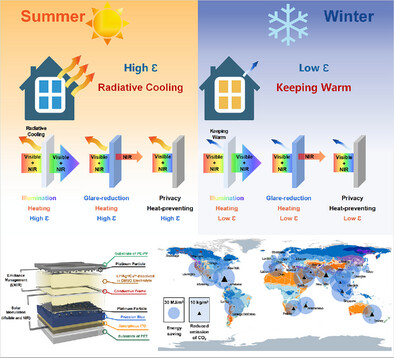A Multimodal Smart Window with Visible‐NIR‐LWIR Electro‐Modulation for All Weather
IF 26.8
1区 材料科学
Q1 CHEMISTRY, MULTIDISCIPLINARY
引用次数: 0
Abstract
Intelligent modulation of solar and thermal radiation for a smart window, including visible, near‐infrared (NIR), and long‐wave infrared (LWIR) spectral tri‐bands (0.38–25 µm), to achieve indoor comfort and energy efficiency is a critical frontier in sustainable building design. However, independent regulations of multi‐functional radiation of visible lighting, NIR heating, and LWIR radiative cooling for dynamic operational requirements and weather conditions are not fully solved. A PET/ITO/PB/Pt‐NPs electrode featuring separated reactions of ion insertion and metal electrodeposition for dual‐band modulation of visible and NIR via precise potential control, enabling multifunctionalities such as illumination, glare reduction, and privacy protection is proposed. A multimodal smart window of lighting‐heating‐emitting electro‐modulation device (LHE‐ED), wherein electrochromism and dynamic emittance are delicately manipulated for tri‐band modulation, possesses six independent electro‐driven states of multi‐scene lighting‐heating‐emitting regulations for the first time, exhibiting excellent wavelength selectivity of △

全天候可见光-近红外-低红外电调制的多模态智能窗口
智能窗户的太阳和热辐射的智能调制,包括可见光、近红外(NIR)和长波红外(LWIR)光谱三波段(0.38-25µm),以实现室内舒适和能源效率是可持续建筑设计的关键前沿。然而,可见光照明、近红外加热和低红外辐射冷却对动态操作要求和天气条件的多功能辐射的独立调节尚未完全解决。提出了一种具有离子插入和金属电沉积分离反应的PET/ITO/PB/Pt‐NPs电极,通过精确的电位控制,可用于可见光和近红外的双波段调制,实现照明,眩光减少和隐私保护等多功能。一种光-加热-发射电调制器件(LHE - ED)的多模态智能窗口,其中电致变色和动态发射度被精细地控制为三波段调制,首次具有6个独立的多场景光-加热-发射调节的电驱动状态,具有优异的波长选择性,△TVis = 41.24%,△TNIR = 53.95%, Δε8‐13µm = 0.35。建筑能源模拟表明,LHE - ED在不同气候区域的表现优于商用低E玻璃,二氧化碳排放量最大减少34.01 kg (m2年)- 1,供暖、通风和空调(HVAC)能耗每年减少34.18%,这为下一代智能窗户在节能和环保方面铺平了道路。
本文章由计算机程序翻译,如有差异,请以英文原文为准。
求助全文
约1分钟内获得全文
求助全文
来源期刊

Advanced Materials
工程技术-材料科学:综合
CiteScore
43.00
自引率
4.10%
发文量
2182
审稿时长
2 months
期刊介绍:
Advanced Materials, one of the world's most prestigious journals and the foundation of the Advanced portfolio, is the home of choice for best-in-class materials science for more than 30 years. Following this fast-growing and interdisciplinary field, we are considering and publishing the most important discoveries on any and all materials from materials scientists, chemists, physicists, engineers as well as health and life scientists and bringing you the latest results and trends in modern materials-related research every week.
 求助内容:
求助内容: 应助结果提醒方式:
应助结果提醒方式:


